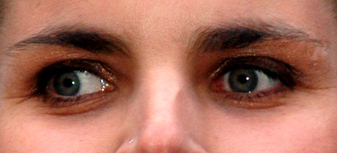 |
In this study, every child aged six to 12 with early-onset myopia and strabismus had the intermittent exotropia type, while neither condition was as common for older children aged 12 to 17. Photo: Ivana Štenclová/Wikimedia Commons. Click image to enlarge. |
It’s not uncommon for children with myopia to develop strabismus, as a significant relationship has been demonstrated between refractive error and the condition. New research, presented this morning at ARVO 2023 in New Orleans, found the most common type of strabismus to develop in young myopes to be intermittent exotropia. The team of investigators from Sydney, Australia also observed in their study that the age of myopia onset played a significant role in the development of intermittent exotropia, reporting a higher incidence rate in children with early-onset myopia.
The Sydney Myopia Study included 876 schoolchildren aged six to 12 and 1,211 children aged 12 to 17 who were followed for five to six years. Spherical equivalent myopia ≤-0.5D and hyperopia ≥3.0D were identified using cycloplegic autorefraction.
In the younger cohort, the incidence rate of strabismus was 8.0/1000 children/year, and in the older cohort, the incidence was 16.3/1000 children per year. The researchers wrote in their abstract that they observed significant changes in the type of strabismus present in the two cohorts over the follow-up period. “Of the children without any strabismus at baseline, intermittent exotropia was the most common type of strabismus to develop, with 1.9% of the younger cohort and 2.2% of the older cohort developing an intermittent exotropia by follow-up,” they reported.
One in four myopic children (25%) in the younger cohort developed a type of strabismus, compared with 1.9% of emmetropic and 4.3% of hyperopic children. “In these children with early-onset myopia, all incident strabismus was intermittent exotropia type,” the investigators pointed out in their abstract, adding that this equates to an incidence rate of 45.5/1000 children/year for intermittent exotropia in those with early-onset myopia. In the older cohort, however, this wasn’t the case; only 4.2% of later-onset myopes (12 to 17 years old) developed strabismus, and the incidence rate of intermittent exotropia in these children was 6.6/1000 children/year.
The team concluded from their study that there’s a significant relationship between refraction and strabismus, “with the age of myopia onset being an influential factor in the development of intermittent exotropia.”
Original abstract content © Association for Research in Vision and Ophthalmology 2023.
Adinanto F, French A, Rose KA. Increased incidence of intermittent exotropia in children with early onset myopia. ARVO 2023 annual meeting. |


